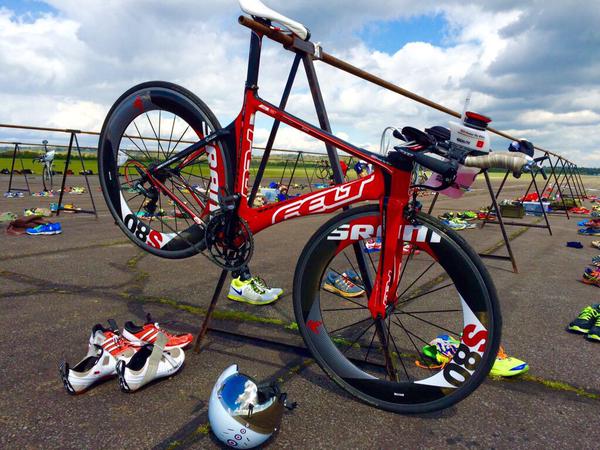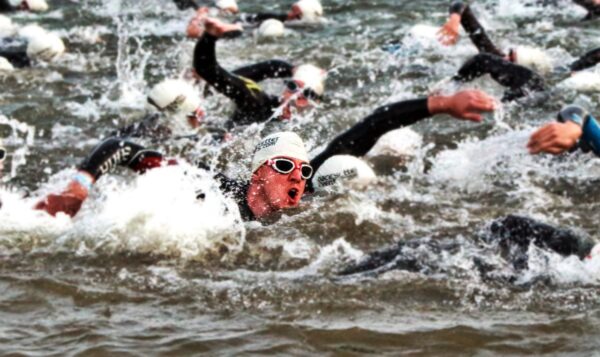Triathlon Captain for South London Harriers Tri Club, Gary Laybourne, takes us through the essentials for getting started in triathlon.
A triathlon. What is your first thought? For most people new to the sport it’s usually along the lines of “some guy at work does that”. Well guess what? In just a few weeks, anyone can be that guy!
Triathlon is the fastest growing sport in the UK. With year on year rises in participation, what used to be a sport for the elites or the major charity fundraisers has now exploded with all shapes, sizes, ages and experiences lining up alongside each other every single weekend. It’s a physical and mental test that many won’t have ever been through before but that’s what makes this sport so great; everyone has been there at some point and understands that no matter who you are, you have trained and sacrificed to be there. How many other sports do you know where professionals and plodders are in the same event and not only that, but socialising, smiling and being cheered equally by the crowds? It’s a pretty addictive place to be that’s for sure!
The easy bit is saying, “I’m going to do one”. The hard part is knowing what to do next!
Firstly, you have three sports to train for. Well, four if you count the art of ‘transition’. For some this is switching kits between each sport as fast as possible but for most, it’s trying not to fall over removing your wetsuit or running out of transition only to realise you still have your helmet on.

Many triathletes I know weren’t initially even able to swim 25m without stopping. Turns out the front crawl you remember doing so well in your youth ends up resembling a drowning octopus. But don’t be put off, I know plenty of people who could not swim a length without stopping who have gone on to complete an Ironman.
There is no short cut for improvement but too many people thrash up and down the lanes for hours on end not realising they are ingraining poor technique that will take twice as long to unlearn later down the line.

Then, there is the cycling. The familiar ‘clack clack clack’ of the £9k top end TT bike entering transition makes even seasoned triathletes think, “my God, this guy can beat Alistair Brownlee’.
Many people that own the fancy kit have got to that point by upgrading as their performance improve, but there’s always one who is the stereotypical ‘all the gear, no idea’ who gets done by a fella on a Boris bike. Does that mean we should point and laugh? Of course not – he has trained hard and wants to race like everyone else so fair play to him.
The main things to remember on the bike are knowing how to get round quickly and how to get round safely. Many novices will structure their training for swimming and running with military precision but then go out and just ride their bike until their backside turns numb. Worse still, knowing the skills to corner and brake, plus the etiquette and safety factors is something all too few take the time to understand in their first event causing danger to themselves and those around them. There is also the small matter of people damaging themselves by setting their bikes up incorrectly so that in the same race you can see a lady who’s saddle is so low it rubs on her back wheel and another fella who jacks it so high trying to be Wiggo that he climbs off running like he’s looking for something on the floor.
So on that note, finally, its the running. Easy – everyone runs, so just move your legs a bit quicker than you would to make the bus. However, running is a high impact activity and the majority of injuries are caused by poor running technique especially when you have just jumped off the bike which has used very different muscles for the past few minutes/hours.
You’ve told me how hard this is but I thought you were going to help? From my experience I promise you that anyone can do a triathlon and you should not be daunted by attempting your first race.
The quickest gains you can make in triathlon is not the kit or training you undertake but having an experienced eye to watch over you. Not many of us can afford the luxury of monthly 1:1 coaching but by simply joining a club and working with coaches and seasoned athletes, you will advance quickly, safely and enjoyably. You’ll meet like-minded people of similar abilities and ambitions who will end up being your partner on the road, in the pool and in the pub. It truly is an incredibly supportive, knowledgeable and fun community.
The other big positive this brings is what you find out about your neighbourhood. You would not believe the amount of trails, roads, lanes, pools, mud baths and hills that you never thought (or hoped) were near you. You will no doubt help contribute to this as well but quick tip – if after a painful ride you suggest a ‘short cut home’ that cuts out the cafe and inputs another hill, you will find your training partners are ‘busy’ for future weeks.
So if you are returning to the sport, transitioning across from many years in one of the three sports or are even fresh out of the box with no clue what to expect, do yourself a favour and give yourself the best possible chance of excelling by joining a club. Those 7am start lines aren’t so horrendous when you have prepared properly and instead of standing on a poolside/jetty by yourself, you are now sharing the experience with fellow club mates who also have a belly full of porridge, wishing they had gone to the loo one more time and will be trading reasons around why this performance won’t be your best because…[insert generic downplay reason].
Yellow Jersey provide insurance products designed specifically for the competitive cycling and triathlon markets. With all claims handled in house by experts recruited out of local cycle clubs and shops, they promise a quick and personal claims process. Click here to find out more.